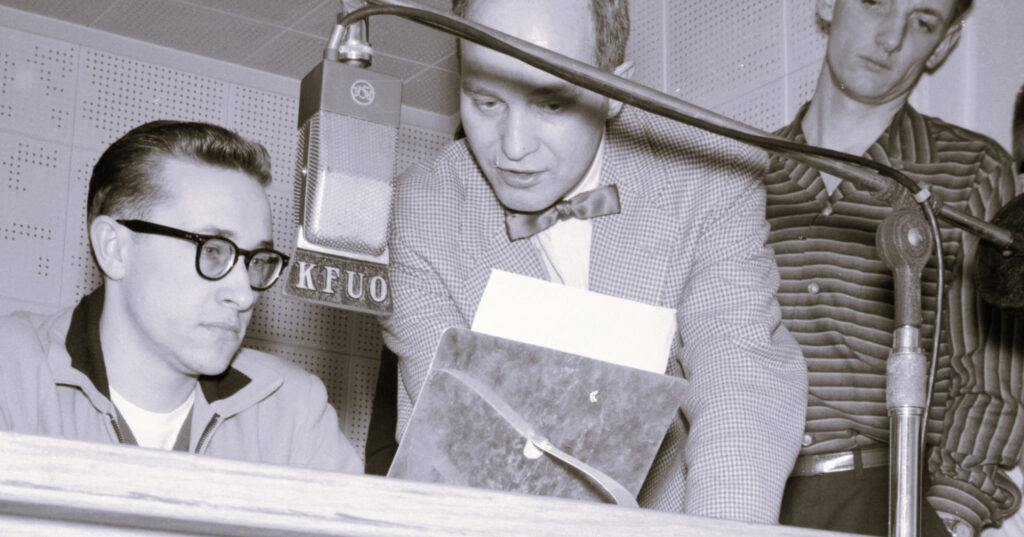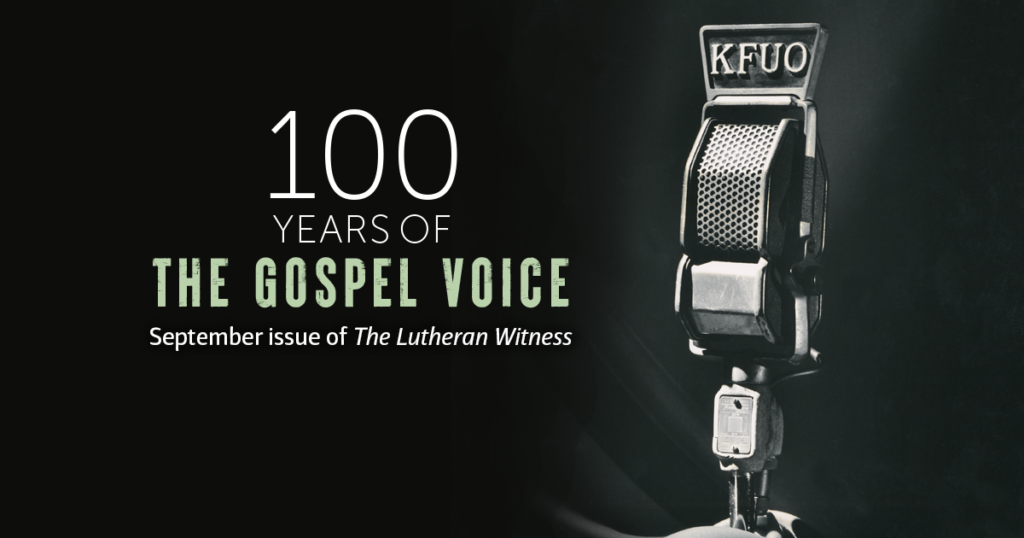By Gerald Perschbacher
Begun as a pioneering outreach effort in 1924, when radio broadcasting was in its natal stage, KFUO was a bold and potentially risky experiment for the LCMS. Launching the station was not easy, entwining time, energy, money and federal approvals. But by God’s grace and the tireless efforts of visionary people, KFUO has continued proclaiming God’s Word over the airwaves for 100 years.
Vision
The trio of pioneers behind KFUO’s creative vision were the Rev. Dr. John H.C. Fritz and the Rev. Dr. Walter A. Maier (both then on the faculty of Concordia Seminary) together with the Rev. Dr. Richard Kretzschmar (chairman for the Board of Control at Concordia Seminary). These three men proposed building a radio studio on the seminary campus, then located on South Jefferson Avenue in St. Louis.
It was a bold idea. Scary, even. The technology required would be cutting-edge, and they knew of no one in church work who had taken on such a project. There were no designated funds to feed the effort. It was, purely and simply, a step of faith — like Peter’s step from the boat on the stormy Sea of Galilee (Matt. 14:28). Yet God graced their enthusiasm with creativity, courage and an unwavering drive to see this booming new communications medium used for the proclamation of the Gospel.
Dedication
On April 5, 1923, Fritz volunteered to be a committee of one to research the idea and report on it to the seminary’s Board of Control. Maier, a dynamic new addition to the faculty, quickly joined the effort. Fritz reported on Oct. 28 that he was willing to bring the need for financial support to the national meeting of the Lutheran Laymen’s League (LLL) in Fort Wayne, Ind. — and his appeal did not go unanswered. The following summer, Fritz enlisted $7,000 in support from the Walther League.
God was at work. The effort was not a chance happening. It was blessed by the Almighty as a vehicle for His Word.
On Oct. 26, 1924, Fritz participated in the cornerstone laying of the new seminary campus in Clayton, a booming suburb of St. Louis. This momentous event was transmitted across the airwaves as KFUO’s maiden broadcast. Soon after, on Dec. 14, 1924, Kretzschmar performed the dedication of the new LCMS radio station, expressing his hope that the unwavering testimony of the Bible would “be carried on the waves of the air, through this station KFUO, to many thousands who will lend their ears. … May it bring salvation, joy, peace and hope into many hearts and many homes.”
The station began its broadcasting legacy in a cramped, hot and windowless attic room of the seminary facility. Simple. Functional. Basic. Heated in all seasons with energy from heaven. Broadcast times were short and regulated by government rules.
Despite these austere beginnings, KFUO was, from the start, a totally serious effort. There was no skimping on energy. Its founders adopted a “let’s do it right from the start” mentality, and their efforts quickly began to bear fruit. Fanning the flame of faith, the Holy Spirit ignited more and more interest in this outstanding idea.
Early Growth
Tall, spindly poles towered over the aging seminary structure to sustain four large parallel antennae, with rows of vertical lines connecting the poles. The transmission’s wavelength was a modest 545.1 meters; its power was 500 watts. Yet even so, its programming (likely due to very little competitive interference at the time) was “heard throughout the United States … on the ocean, in Canada, and in the West Indies,” according to a four-page handout issued by the seminary in October 1925. Programs aired that month on Sunday evenings at 9:15 p.m., Monday evenings at 8 p.m. and Wednesday evenings at 9:15 p.m. Pastors in Missouri and Illinois took turns at the mighty mic, under the supervision of KFUO’s new program director, the Rev. Herman H. Hohenstein.
The response at that time was momentous: A photo printed in the brochure showed fan mail as deep as 18 inches covering the better part of a library table, with Fritz reading a letter while a typist sat nearby entering his reply on a heavy manual typewriter.
Recognizing KFUO’s potential for growth as a Synodwide ministry, the LLL petitioned the LCMS on June 15, 1926, to “take over the station … and its maintenance.”
On KFUO’s third birthday on Dec. 14, 1927, leaders were basking in the vigorous success of the young station. During those three years, 847 programs were broadcast. A whopping 27,228 individuals, including 111 blind individuals, were added to the mailing list. Countless pieces of Christian literature (including 904 Lutheran hymnals) were distributed or mailed, and 306 Bibles were provided, together with devotional material in Braille for the visually impaired.
Expansion and Challenges
In 1928, KFUO began airing daily programming Monday through Saturday at time slots from 7:15 a.m. to 10:30 p.m.; Sunday programs ran from 3:00 p.m. to 9:15 p.m. Broadcasts included stories, music, hymnody, chapel devotionals, radio dramas, special topic talks, biblical texts, reports from the mission field and young people’s programming. At times, listeners even heard a seminary student play sacred music on his marimba. Various languages were also heard: English, German, Slovak, Norwegian, Spanish, French and more.
At this time, KFUO shared the same wavelength used in the St. Louis area by station KSD (connected with the St. Louis Post-Dispatch). During a 12-year period there were times when KSD petitioned federal officials for exclusive use of certain time slots. As early as 1928, the matter was becoming a challenge for KFUO, which was asked to adjust its schedule. In the rush to radio, a timing logjam was developing not just in St. Louis but across the land. There were eight other stations using the same wavelength as KFUO — in New York, Ohio, North Dakota and South Dakota.
KFUO’s officials quickly became adept at voicing their concerns to federal regulators, and they remained steadfastly vigilant in protecting the rights and privileges of broadcasting for the good of their listeners. Not until the rise of digital streaming
in the late 1990s was KFUO finally able to reach all its eager listeners without interference and achieve its dream of becoming “Worldwide KFUO.”
Coast to Coast
Even so, the founders’ vision for Lutheran radio broadcasting was so strong that, amid the gloomy days of the Great Depression, the KFUO Radio Committee resolved to move toward nationwide coverage, pending approvals by church and state. Maier (still partnering with Fritz) began preparing biblical, Christ-centered messages to beam across the landscape as “The Lutheran Hour.” The first episode aired Oct. 2, 1930, on KFUO and 32 additional stations in the CBS network. Knowing that if KFUO were to take this giant step forward, expansion would be needed, the LLL pledged “to rebuild KFUO on the campus of the new seminary at a cost of $50,000.”
Fritz did not stop there. Empowered by the LCMS convention in 1935 to plan and promote the vigorous growth of KFUO in the years to come, he and Maier worked to expand syndication of “The Lutheran Hour” coast to coast. Hohenstein and a growing circle of others (including successful businessmen stirred by the Spirit) shared their dream. The KFUO Radio Committee in the 1940s sparked additional expansion with the $300,000 Forward Movement in 1946.
Moving Forward in Faith
Sadly, the sudden and unforeseen death of Fritz on April 12, 1953, interrupted plans to continue broadening KFUO’s reach into the booming world of television. Others would need to take up that new challenge. At this point, Hohenstein, who had served as KFUO’s director for over two decades, eased to the forefront as a major and necessary influence, bringing the station’s Christ-centered mission forward into a new era.
The Rev. (later Dr.) Elmer J.C. Knoernschild was also an active voice and creative influence on KFUO’s maturing years, even into the 1960s. He coordinated various regular and special programs, including “Reveries in Rhyme,” “Paging Through the Diary of a Missionary” (written by the Rev. C.F. Schmidt of Rosebud, Mo., about outreach to the Chinese), “Radio News” and “Children’s Question Box.” The questions raised for young listeners in this last show were quaintly interesting: “Who invented the balloon?” “Why is snow white?” “Why is time worth money?” “Which hymn is the greatest of the English language?” and “If the air weighs
15 pounds to the square inch, why does it not press us flat?”
Other early programs of special interest included “My Childhood Scrapbook” (1934), “Playlets of the Holy Land” (1935), “Moments with the Old Masters” (a classical music program airing 1936–37), “The Road Back to God” (1940), “Search the Scriptures” and “Seeking the Truth” (both in 1940–41), “Salute to States” (1941) and “Christian School of the Air” (1944–47, featuring brother Dickie, sister Marge, their parents and friend Eddie in a series of heart-to-heart experiences and conversations).
KFUO was launched by faith. As the apostle Peter said on the great Pentecost, “This Jesus God raised up, and of that we all are witnesses” (Acts 2:32 RSV). The work of KFUO clearly points to Christ. Always. And forever!

This article originally appeared in the September 2024 issue of The Lutheran Witness.




I helped start the only other Lutheran radio station outside of St. Louis in this country in 1990. It was started with the concept of building a network of Lutheran stations. We used much programming from KFUO, but could not fill our day completely with their programming. Consequently, we used other programming we could get that was not Lutheran, but usually did not present challenges to it. We were owned by the LCMS at first and after a few years, we became independent. From the outset we had challenges. KFUO’s identifier was aired over our station. Technology existed even at that time that could automate station breaks at specific times and cut their identifier out so our own could be inserted. This was never used over our 30 years of existence. There were a number of other radio stations that took programming like Issues, Etc. and aired it. However, these non-Lutheran stations would not put up with KFUO identifiers being put on their stations. They would also not put up with radio talk about local St. Louis events. An uplink was installed at the Interantional Center in St. Louis that put KFUO’s signal up on a satellite. The footprint of the down signal was all of North America. This was expensive so with low demand for Lutheran programming it was discontinued after a few years. We continued getting KUO programming using the internet as our link. In those days, AM stations like ours could not have remote broadcasting local stations. Only FM could be put up on the satellite so that stations cold be planted all over the country. KFUO’s sister FM station broadcast only classical music. Nothing else. That FM station was 100,000 watts and would have covered the St. Louis area very well. Its signal could have been put up on satellite feeding hundreds of local radio stations repeating their Lutheran network. Unfortunately, the FM was sold for millions of dollars as it was an asset in big demand in the St. Louis area. That was the end of the efforts to have a satellite network. Of course, today, a network could be made by using the internet to feed programming to stations. I am very sad that the effort to create a Lutheran radio network was never sufficient to make it successful. KFUO is the oldest continuously operating Christian radio station in the US, but has been passed by many other Christian, non-Lutheran networks. I think Lutherans could have done better.
I think there will always be a place for Christian radio, because millions still turn on their car radios as they travel to and fro. But I see more people going to internet podcasts these days, as they pick and choose topics which interest them. Christian radio competes with multiple podcasts and news platforms on the internet highway, and on cable, and to be honest, the thirst for biblical truth from God’s word in this post Christian era is greatly diminished. But even so, the Gospel must go forth, using these technologies to reach the elect wherever they happen to be. In an age of inclusive and humanistic leanings, the church is exclusive and must follow Christ and His word regardless of the fact that the message is unpopular, often regarded with disdain, and indifference, and avoided by masses of people. This is not new. Technology may change, but the world still wars against the Spirit. Soli Deo Gloria